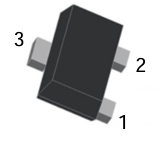Common Base Configuration
Date:2025-05-28 Categories:Product knowledge Hits:390 From:Guangdong Youfeng Microelectronics Co., Ltd
Small signal transistors ,In this configuration, the base is common to the input and output, providing high voltage gain but low input impedance. It is ideal for high-frequency applications or current buffer stages. The emitter serves as the input terminal, and the collector as the output. A typical application is in radio frequency (RF) circuits where a 2N3904 transistor in common base configuration can be used for impedance matching.
Common Collector Configuration (Emitter Follower)
Also known as an emitter follower, this configuration offers high input impedance and low output impedance, making it perfect for buffer stages. The collector is connected directly to VCC, and the output is taken from the emitter through a resistor. It provides current gain but no voltage gain, and the output signal is in phase with the input. For instance, an emitter follower using a BC547 transistor can be used to drive a load without loading the previous stage.
Small signal transistorsProper biasing is essential to keep the transistor in the active region for linear amplification. The most common biasing technique is the voltage divider bias, which uses two resistors (R1 and R2) connected between VCC and ground to set the base voltage. A emitter resistor (RE) is included to stabilize the biasing against temperature variations and component tolerances.
Small signal transistorsDetermine the desired collector current (IC) based on the application, usually between 1mA and 10mA for small signal transistors.
Calculate the emitter voltage (VE) as VE = IC * RE, typically setting VE to 10% to 20% of VCC for stability.
Set the base voltage (VB) as VB = VE + VBE, where VBE is approximately 0.7V for silicon transistors.
Choose R1 and R2 such that the current through the voltage divider (IR1) is at least 10 times the base current (IB) to ensure the biasing is relatively independent of IB. IB can be calculated as IB = IC / hFE.
R1 = (VCC - VB) / IR1, and R2 = VB / IR1.
For example, in a circuit with VCC = 12V, IC = 5mA, RE = 1kΩ, and hFE = 100:
VE = 5mA * 1kΩ = 5V
VB = 5V + 0.7V = 5.7V
Assuming IR1 = 500μA (10 times IB, where IB = 5mA / 100 = 50μA),
R1 = (12V - 5.7V) / 500μA = 12.6kΩ (use 12kΩ or 13kΩ standard resistor)
R2 = 5.7V / 500μA = 11.4kΩ (use 11kΩ standard resistor)

Previous:
Classification, Structure, and Principle of MOSFET
Next:
Input and Output Coupling
